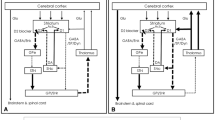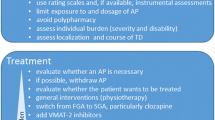Abstract
Clozapine has had a uniquely favorable motor system side effect profile since its initial evaluations. This has been convincingly corroborated by many double blind, single blind, and open studies treating acute and chronic psychosis. The acute extrapyramidal syndromes of dystonia, akathisia and parkinsonism infrequently occur, whereas these syndromes develop in up to 75% of patients receiving traditional neuroleptics. Tardive dyskinesia can be suppressed with higher doses of clozapine given over extended periods. However, an antipsychotic effect can be achieved in many patients at doses below the dyskinesia suppressing level. There is no established causative relationship between clozapine and tardive dyskinesia, but there is a theoretical basis that this may occur. Preliminary data suggest clozapine has mild antiparkinsonian effects as well as efficacy in controlling dopamine agonist-induced psychosis without aggravating parkinsonism. A much wider use of clozapine will further characterize the magnitude of differences compared to other neuroleptics, and identify additional indications for this special compound.
Similar content being viewed by others
References
Angst J, Bente D, Berner P, Heimann H, Helmchen H, Hippius H (1971) Das klinische Wirkungsbild von Clozapin: Untersuchung mit dem AMP-System. Pharmakopsychiatrie 4:200–211
Bartholini G, Haefely W, Jalfre M, Keller HH, Pletscher A (1972) Effects of clozapine on cerebral catecholaminergic neurone systems. Br J Pharmacol 27:180–190
Bürki HR, Ruch W, Asper H (1975) Effects of clozapine, thioridazine, perlapine and haloperidol on the metabolism of the biogenic amines in the brain of the rat. Psychopharmacologia 41:27–33
Caine E, Polinsky R, Kartzinel R, Ebert M (1979) The trial use of clozapine for abnormal involuntary movement disorders. Am J Psychiatry 136:317–320
Carroll BJ, Curtis GC, Kokmen K (1977) Paradoxical response to dopamine agonists in tardive dyskinesia. Am J Psychiatry 134:785–789
Casey DE (1987) Tardive dyskinesia. In: Meltzer HY (ed) Psychopharmacology: the third generation of progress. Raven Press, New York, pp 1411–1419
Casey DE (1988) Affective disorders and tardive dyskinesia. L'Encephale 14:221–226
Casey DE, Gerlach J (1986) Tardive dyskinesia: what is the long-term outcome? In: Casey DE, Gardos G (eds) Tardive dyskinesia and neuroleptics: from dogma to reason. Am Psychiatr Press, Washington, DC, pp 76–97
Casey DE, Keepers GA (1988) Neuroleptic side effects: acute extrapyramidal syndromes and tardive dyskinesia. In: Casey DE, Christensen AV (eds) Psychopharmacology: current trends. Springer, Berlin Heidelberg New York, Tokyo, pp 74–83
Chiu E, Burrows G, Stevenson J (1976) Double-blind comparison of clozapine with chlorpromazine in acute schizophrenic illness. Aust N Z J Psychiatry 10:343–347
Chouinard G, Annable L (1976) Clozapine in the treatment of newly admitted schizophrenic patients. J Clin Pharmacol 16:289–297
Claghorn J, Honigfeld G, Abuzzahab F, Wang R, Steinbook R, Tuason V, Klerman G (1987) The risks and benefits of clozapine versus chlorpromazine. J Clin Psychopharmacol 7:377–384
Cole JO, Gardos G, Tarsy D (1980) Drug trials in persistent dyskinesia. In: Fann WE, Smith RC, Davis JM, Domino EF (eds) Tardive dyskinesia: research and treatment. SP Medical and Scientific Books, New York, pp 419–427
Delay J, Deniker P (1957) Characteristiques neuro-physiologiques des medicaments neuroleptiques. Rapport Symposium Internationale Medicaments Psychotropies. In: Garratini S, Ghetti V (eds) Psychotropic drugs. Elsevier, Amsterdam, pp 485–501
DeMaio D (1972) Clozapine, a novel major tranquilizer. Arzneimittelforschung 22:919–923
Doepp S, Buddeberg C (1975) Extrapyramidale Symptone unter Clozapin. Nervenarzt 46:589–590
Ekblom B, Haggstrom JE (1974) Clozapine compared with chlorpromazine: a double-blind evaluation of pharmacological and clinical properties. Curr Ther Res 16:945–957
Fischer-Cornelssen KA, Ferner UJ (1976) An example of European multicenter trials: multispectral analysis of clozapine. Psychol Bull 12:34–39
Gerbino L, Shopsin B, Collora M (1980) Clozapine in the treatment of tardive dyskinesia: an interim report. In: Fann WE, Smith RC, Davis JM, Domino EF (eds) Tardive dyskinesia: Research and treatment. SP Medical and Scientific Books, New York, pp 475–489
Gerlach J, Casey DE (1988) Tardive dyskinesia. Acta Psychiatr Scand 77:369–378
Gerlach J, Simmelsgaard H (1978) Tardive dyskinesia during and following treatment with haloperidol plus biperiden, thioridazine, and clozapine. Psychopharmacology 59:105–112
Gerlach J, Koppelhus P, Helweg E, Monrad A (1974) Clozapine and haloperidol in a single-blind cross-over trial: therapeutic and biochemical aspects in the treatment of schizophrenia. Acta Psychiatr Scand 50:410–424
Gerlach J, Thorsen K, Fog R (1975) Extrapyramidal reactions and amine metabolites in cerebrospinal fluid during haloperidol and clozapine treatment of schizophrenic patients. Psychopharmacologia 40:341–350
Gross H, Hackl H, Kaltenbaeck E (1970) Results of double-blind study of clozapine and thioridazine. VII CINP Congress, Prague
Hemphill RE, Pascoe FD Zabow T (1975) An investigation of clozapine in the treatment of acute and chronic schizophrenic and gross behaviour disorders. S Afr Med J 49:2121–2125
Hyttel J, Larsen JJ, Christensen AV, Arnt J (1985) Receptor-binding profiles of neuroleptics. In: Casey DE, Chase TN, Christensen AV, Gerlanch J (eds) Dyskinesia research and treatment. Psychopharmacology Supplementum 2, Springer, Berlin Heidelberg New York, pp 9–18
Itoh H, Miura S, Yagi G, Sakurai S, Ohtsuka N (1977) Some methodological considerations for the clinical evaluation of neuroleptics-comparative effects of clozapine and haloperidol on schizophrenics. Folia Psychiatr Neurol Jpn 31:17–24
Jenner P, Marsden CD (1983) Neuroleptics and tardive dyskinesia. In: Coyle JT, Enna SJ (eds) Neuroleptics: neurochemical, behavioral, and clinical perspectives. Raven Press, New York, pp 223–253
Juul Povlsen U, Noring U, Fog R, Gerlach J (1985) Tolerability and therapeutic effect of clozapine. A retrospective investigation of 216 patients treated with clozapine for up to 12 years. Acta Psychiatr Scand 71:176–185
Kane J, Honigfeld G, Singer J, Meltzer H (1988) Clozapine for the treatment-resistant schizophrenic. Arch Gen Psychiatry 45:789–796
Keepers G, Casey DE (1987) Prediction of neuroleptic-induced dystonia. J Clin Psychopharmacol 7:342–344
Keepers GA, Clappison VJ, Casey DE (1983) Initial anticholinergic prophylaxis for neuroleptic-induced extrapyramidal syndromes. Arch Gen Psychiatry 40:1113–1117
Kirkegaard A, Hammershoj E, Ostergard P (1982) Evaluation of side effects due to clozapine in long-term treatment of psychosis. Arzneimittelforschung 32:465–468
Kuha S, Miettinen E (1986) Long-term effect of clozapine in schizophrenia: a retrospective study of 108 chronic schizophrenics treated with clozapine for up 7 years. Nord Psykiatr Tidsshrl 40:225–230
Matz R, Rick W, Oh D, Thompson H, Gershon S (1974) Clozapine — a potential antipsychotic agent without extrapyramidal manifestations. Curr Ther Res 16:687–695
Meltzer HY, Luchins DJ (1984) Effect of clozapine in severe tardive dyskinesia: a case report. J Clin Psychopharmacol 4:286–287
Pakkenberg H, Pakkenberg B (1986) Clozapine in the treatment of tremor. Acta Neurol Scand 73:295–297
Panteleeva MY, Tsutsul Kovskaya MY, Belyaev BS, Minsker EI (1987) Clozapine in the treatment of schizophrenic patients: an international multicenter trial. Clin Ther 10(1):57–68
Pope HG, Cole JO, Choras PT, Fulwiler CE (1986) Apparent neuroleptic malignant syndrome with clozapine and lithium. J Nerv Ment Dis 174:493–495
Sayers A, Bürki H, Ruch W, Asper H (1975) Neuroleptic-induced hypersensitivity of striatal dopamine receptors in the rat as a model of tardive dyskinesias. Effects of clozapine, haloperidol, loxapine and chlorpromazine. Psychopharmacologia 41:97–104
Sayers A, Bürki H, Ruch W, Asper H (1976) Anticholinergic properties of antipsychotic drugs and their relation to extrapyramidal side-effects. Psychopharmacology 51:15–22
Scholz E, Dichgans J (1985) Treatment of drug-induced exogenous psychosis in parkinsonism with clozapine and fluperlapine. Eur Arch Psychiatr Neurol Sci 235:60–64
Shopsin B, Klein H, Aaronsom M, Collora M (1979) Clozapine, chlorpromazine, and placebo in newly hospitalized, acutely schizophrenic patients. Arch Gen Psychiatry 36:657–664
Simpson GM, Varga E (1974) Clozapine — a new antipsychotic agent. Curr Ther Res 16:679–686
Simpson G, Lee JH, Shrivastava RK (1978) Clozapine in tardive dyskinesia. Psychopharmacology 56:75–80
Small JG, Milstein V, Marhenke JD, Hall DD, Kellams JJ (1987) Treatment outcome with clozapine in tardive dyskinesia, neuroleptic sensitivity, and treatment-resistant psychosis. J Clin Psychiatry 48:263–267
Stille G, Lauener H, Eichenberger E (1971) The pharmacology of 8-chloro-11-(4-methyl-1-piperazinyl)-5H-dibenzo diazepine (clozapine). Il Farmaco 26:603–625
Toenniessen LM, Casey DE, McFarland BH (1985) Tardive dyskinesia in the aged. Arch Gen Psychiatry 42:278–284
Thorup M, Fog R (1977) Clozapine treatment of schizophrenic patients; Plasma concentration and coagulation factors. Acta Psychiatr Scand 55:123–126
Van Praag HM, Korf J, Dols LCW (1976) Clozapine versus perphenazine: the value of the biochemical mode of action of neuroleptics in predicting their therapeutic activity. Br J Psychiatry 129:547–555
Van Putten T, Mutalipassi LR Malkin MD (1974) Phenothiazine-induced decompensation. Arch Gen Psychiatry 30:102–105
White FJ, Wang RY (1983) Differential effects of classical and atypical antipsychotic drugs on A9 and A10 dopamine neurons. Science 221:1054–1057
Author information
Authors and Affiliations
Rights and permissions
About this article
Cite this article
Casey, D.E. Clozapine: neuroleptic-induced EPS and tardive dyskinesia. Psychopharmacology 99 (Suppl 1), S47–S53 (1989). https://doi.org/10.1007/BF00442559
Issue Date:
DOI: https://doi.org/10.1007/BF00442559




